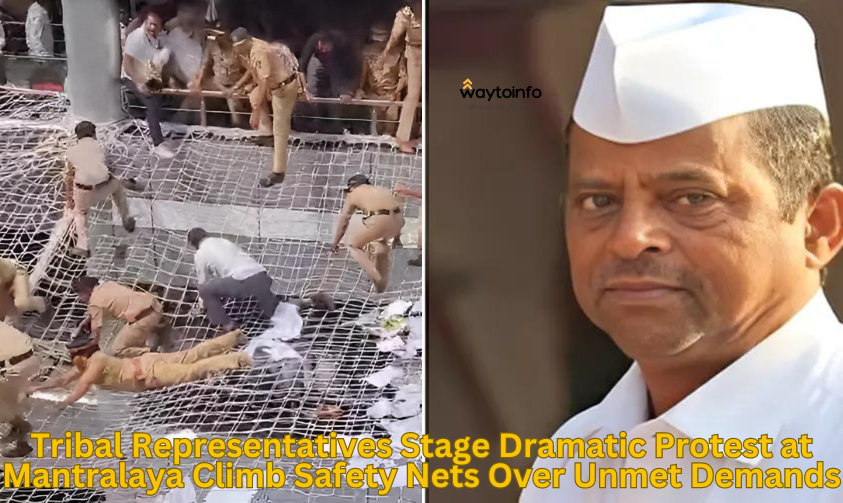
In a striking and unusual protest at Mantralaya, the headquarters of the Maharashtra state government, a group of tribal community representatives took an audacious stand on Friday, climbing the safety nets designed to prevent suicide attempts inside the building. This bold action was triggered by what they claimed was Chief Minister Eknath Shinde’s failure to meet with them and address their grievances.
Leading the protest were prominent political figures, including Deputy Speaker of the Assembly Narhari Zirwal from the Nationalist Congress Party (NCP), Bahujan Vikas Aghadi MLA Rajesh Patil, and BJP Member of Parliament Hemant Savara, all hailing from tribal communities. Their demands centered on the removal of a stay on tribal youth recruitment under the Panchayats (Extension to Scheduled Areas) Act (PESA) and opposing the inclusion of the Dhangar community in the Scheduled Tribes (ST) reservation quota.
The Unfolding of a High-Profile Protest
The protest took place during a state cabinet meeting in progress at Mantralaya, adding significant political pressure and drama to the day’s events. The tribal leaders, after arriving at the government complex on Friday afternoon, escalated their protest by climbing onto the security nets located on the second floor of the seven-story building. Zirwal, Patil, and Savara were joined by two other individuals in this act of defiance, which drew immediate attention from government officials and security personnel alike.
This bold display was complemented by a sit-in protest led by other tribal MLAs, including Kiran Lahamte and Hiraman Khoskar, who positioned themselves in the corridor on the same floor as the protesters on the nets. Together, the demonstration illustrated a strong, unified stand across party lines as the representatives sought to bring urgency to their demands.
Key Demands Tribal Recruitment and Reservations
At the heart of the protest were two key issues that have long been contentious in Maharashtra’s political landscape. First, the protesters called for the lifting of a stay on the recruitment of tribal youths under the PESA Act, a crucial piece of legislation that extends special provisions to tribal areas, including safeguarding their rights to self-governance and resources. The stay on recruitment, they argue, has left many tribal youths without job opportunities, exacerbating poverty and unemployment in their communities.
Secondly, the protestors expressed strong opposition to the Dhangar community’s demand for inclusion in the ST reservation category. The Dhangar community, traditionally a nomadic and pastoral group, currently benefits from reservations in a sub-category under the Other Backward Classes (OBC) quota.
However, their long-standing push for inclusion in the ST category has been met with resistance from tribal groups, who argue that the addition of the Dhangar community would dilute the benefits meant for the existing Scheduled Tribes. The tribal leaders fear that this move would erode the already limited resources allocated to ST communities, particularly in terms of education and employment opportunities.
The Government’s Response and Security’s Role
As the dramatic scene unfolded, security personnel at Mantralaya were forced to intervene, negotiating with the protesters to come down from the safety nets and join their colleagues in the sit-in protest. After significant persuasion, the representatives finally descended and resumed their protest alongside other tribal MLAs, further solidifying the political nature of their grievances.
The protesters’ cross-party alliance underscored the depth and breadth of their concerns, highlighting how the issues facing tribal communities have transcended political divisions. Zirwal, leading the protest, issued a strong statement, declaring that they would not leave Mantralaya without meeting Chief Minister Shinde.
He further warned that should their demands remain unmet, they would escalate their protest to a statewide level, signifying that the tribal representatives are prepared for a long and determined struggle.
The backdrop of the Dhangar Community’s Campaign
The Dhangar community has been campaigning for inclusion in the ST category for years, arguing that their nomadic lifestyle and socio-economic disadvantages warrant the same protections and benefits provided to Scheduled Tribes. Currently, they receive reservations under a sub-category of the OBCs, but this classification does not offer them the same level of benefits as the ST category.
The Dhangar leaders believe that being included in the ST list would improve their community’s access to government jobs, education, and welfare schemes. However, their demands have sparked tension with existing ST communities, who argue that they have historically been marginalized and that the benefits of the ST quota should be reserved exclusively for them.
A Call for Immediate Action
As the protest continued, the timing could not have been more critical. The state cabinet meeting was ongoing, and the presence of high-ranking officials added pressure for a resolution. With widespread media coverage, the protestors’ demands were brought into the spotlight, forcing the state government to confront the issues head-on.
Zirwal’s declaration that “we will not leave Mantralaya before having a meeting with the chief minister” left little room for ambiguity. His threat of a larger statewide protest, should the tribal community’s demands go unheard, added urgency to the situation. As the situation unfolded, it became clear that the government would need to respond decisively to prevent further escalation.
Conclusion A Stand for Tribal Rights
The tribal representatives’ protest at Mantralaya on Friday was a clear demonstration of the frustration and determination within the community. Their climb onto the safety nets symbolized the precarious nature of their position—caught between competing demands for resources and recognition, and the government’s apparent reluctance to engage with their concerns. As the state government faces mounting pressure to address tribal recruitment and reservation issues, the events at Mantralaya serve as a stark reminder that these long-standing grievances will not be easily brushed aside.
Read Also Prashant Kishore Launches Jan Suraj Party A New Era in Bihar Politics
Leave a Reply